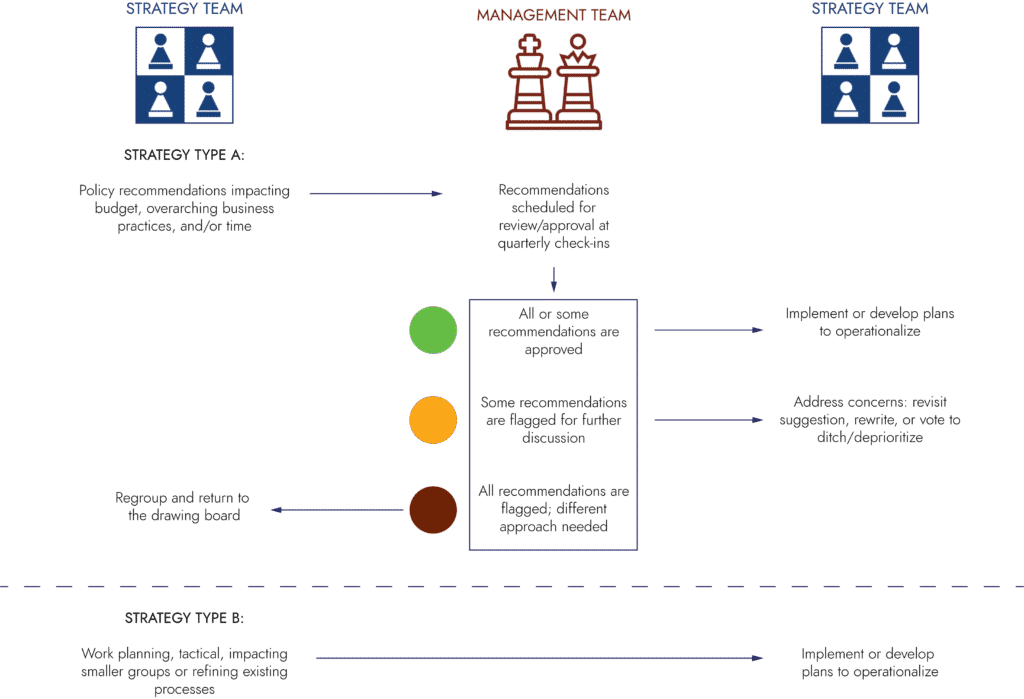Moving a glacier in sixteen parts: lessons from GreenerU’s own strategic plan process (Part II of II)
Strategic plans do a great job of helping organizations gain alignment and focus on common outcomes. But one of the trickiest parts about developing a plan is actually implementing it. Here at GreenerU, we put ourselves to the test. This is Part II of a two-part article.

When we left off in Part I, GreenerU was struggling with ambiguity, particularly as we were facing a glacier of change. One of the challenges we wrestled with was in finding a way to advance our strategic planning efforts alongside daily business operations.
And then coronavirus hit.
Like many of you, we found ourselves working from home, learning how to Zoom, juggling childcare or home-schooling with an uncertain future. Mornings have included internal debates on whether to put on pants with a zipper or stick with flannel pajamas. The reality of a global pandemic has only begun to sink in—and the devastating effects of it aren’t even fully understood yet.
That certainly remains true for GreenerU, too. When we aren’t even certain of what our future holds, does our pre-covid strategic plan still make sense?
To solve this, we did a review of our original goals and strategies through the lens of the current pandemic. A number of strategies were temporarily shelved, while a few others took higher priority—and of course, a major one was added: how we’re going to manage the current crisis.
But prior to all this, we had begun to make significant progress. Here’s how.
Who’s in charge here?
Initially, it was decided that the four members of the management team would split up the responsibilities of driving the 14 teams’ progress and keeping momentum moving forward. Each management team member was to report out monthly and keep each other accountable.
After about six months, however, it became clear that bandwidth, other priorities, and different communication styles were hampering momentum. Like all of our clients, we all still have full-time jobs—it’s not as though the strategic plan replaces the tasks at hand. We still have people to help and a business to run.
So, for some, there was a patch of the strategic plan blues. What had we gotten ourselves into? Did we bite off more than we could chew? How could we possibly get everything done that we set out to do?
That’s when we realized we needed a taskmaster—someone who would keep nipping at the heels of each of the plan’s strategies to keep it moving forward. There was a person on staff who was well suited to become the strategic plan’s project manager: me.
As marketing director, my job intersects with those of nearly every other person who works at GreenerU. I also don’t need to meet a quota of time spent on client work. So it made sense for me to be charged with keeping 16 balls in the air at the same time.
Pollinating ideas with a project manager
Now that we have a project manager for our strategic plan, we are stitching together a whole bunch of pieces that ultimately make up the whole cloth of a new and improved company. Knowing that, say, we have a new project finance mechanism emerging out of Strategy 2.2 is helpful in understanding how to plan for growing our company’s service territory (Strategy 5.1). The value in having a project manager with oversight over an entire process such as this is the cross pollination of information. It ensures that we aren’t doubling up our efforts.
Another way of ensuring that everyone is on the same page is through quarterly written communication with updates on each strategy, which is distributed to the full staff and board. I also share with staff and the board a quarterly progress graph that helps visualize how far we’ve come. Again, with our four phases—investigate, design, implement, measure—it helps us take apart the complexity of each strategy and more accurately measure progress.
Getting buy-in
There have still been some overwhelming parts of this process. With some aspects of the plan, we’re talking about changes that get to the heart of who we are. That can be uncomfortable. Even though we’ve theoretically agreed on our vision and created strategies around it, each person comes with different perspectives and priorities. And when push comes to shove, there are legitimate concerns about not just what, but when and how we will implement changes.
What we started to understand among our strategic plan goals was that there were different types that needed varying levels of buy-in. Some goals are “just do it” kinds of goals—“develop a dynamic financial reporting tool” and “create a project completion process,” for example. We need to make sure those are well crafted so they actually work.
But some goals involve decisions that key decision-makers will need to embrace, such instituting a policy for working remotely or fundamentally restructuring our sales process. To make this process easier, we developed something called a “stoplight” evaluation—green for general agreement, yellow for some reservations, red for a pretty hard no.

Dealing with volume
Some strategies are like hydromorphic polymer creatures. Once they get wet, they start to expand to an unwieldy size, well beyond how they started out. Likewise, it can be tough to fulfill your original vision once you’ve made discoveries about your plan that are less feasible than you expected.
One example of this is GreenerU’s aspirations of becoming B Corp-certified. This is a designation by a nonprofit entity, B Lab, that measures for-profit companies’ efforts decisions, we think about environmental and community impacts, too.
Though our company culture and values align very strongly with B Corp values, talking about becoming B Corp-certified ended up being a huge can of worms. There were a couple hundred criteria our strategy evaluated and whittled down before forwarding a series of recommendations to the management team. But our whittling needed even more whittling. We had to make a lot of tough decisions as a team before we could forward a list of suggested action items that we could reasonably achieve in the near term.
And with each criterion came a rabbit hole of more questions and decisions, in which we invested a lot of time upfront—call it high first costs. But spending the time now and keeping careful records of our conversations would ultimately lead us to make decisions more easily down the road.
Operationalizing the plan: the implementation phase
After a full year of creating a plan and another full year of fleshing out much of the plan, we’re still working through aspects that we’ll ultimately operationalize. And you know what? That’s great momentum!
It’s incredibly important to remember that strategic plans are an iterative process. The fact of the matter is that things will shift along the way. There will always be ambiguity. But the very existence of a strategic plan means we’ve started having the right conversations, and we will continue revisiting and revising and whittling and shaping as time marches on. That is exactly how it’s supposed to work.
Some of the challenges we face are compliance and accountability. If we come up with a new standardized project management process, for example, how do we bake in enough simplicity and universality to make sure all of our projects are managed the same way? How do we make sure we’re all following the same intricate choreography?
We’re also discovering that all these new policies, procedures, guidelines, new programs, and/or suggestions need a home. These pronouncements are meaningless without an operational plan. There isn’t an obvious place to store this collective knowledge, and the risk is it becomes the institutional knowledge of only the few who worked on the teams.
Note: for many, “policies, procedures, and guidelines” makes people react like a vampire to daylight and grumbling about bureaucracy and red tape. It becomes an easy punching bag for reasons not to act. Sure, there are some cautionary tales around having too many rules—you don’t want to squash people’s creativity or strip anyone of their abilities to make adult decisions.
But a smart set of policies creates a framework that allows both our culture and business to thrive. We’re turning value statements into deliberate actions. And having wrestled with much of this up until now, we’ve centered the clay on the pottery wheel, and hopefully will be able to get a grip on our situation before the unwieldy, lopsided wobbliness of pandemic uncertainty makes clay fly all over the room.
In short, we’ve learned a lot of lessons down this winding and sometimes rocky road. We’ve wrestled with a lot of tough questions. We’ve searched our souls. We’ve developed new tools and workarounds so we hopefully don’t get stuck—especially as we try to navigate a new world.
Having been through the highs and lows of the multiple phases of strategic planning has helped us gain even greater insight into how to help your institution craft its visions, goals, and strategies thoughtfully. We want you to benefit from what we’ve found! Please Talk to Us and start a conversation.



